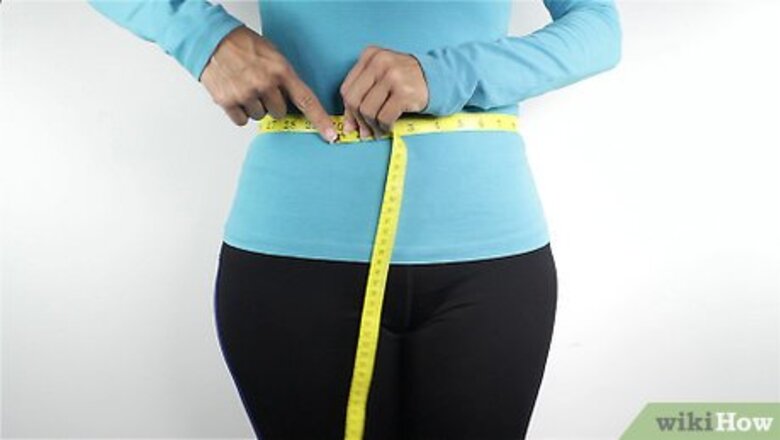
views
Taking the Measurement

Measure your waist with a fabric measuring tape. Decide how high you want your garment to sit on your waist and wrap a fabric measuring tape around your waist at that point. You might wrap the tape measure around your waist at a point about 3 inches (8 cm) below your navel for traditional low-rise pants, for instance. Then, read the measurement.Tip: Try to wear pants or a skirt that fits close to your skin and remove any bulky jackets or tops that might make it difficult to take an accurate measurement. If you don't have a fabric measuring tape, wrap a string or piece of yarn around your waist. Then, use a ruler to measure the length of string.
Subtract 2 inches (5.1 cm) from the measurement and cut the elastic. Once you have your waist measurement, remove the measuring tape and subtract 2 inches (5.1 cm) from it. Unwrap a length of your elastic and mark a length of elastic based on your measurement. Then, cut the adjusted measurement. For example, if your waist measurement was 30 inches (76 cm), subtract 2 inches (5.1 cm) to get an elastic measurement of 28 inches (71 cm).

Wrap the elastic around your waist and pin it to see if it's comfortable. Now take the elastic and wrap it where your garment's waistband will fall. Pin the ends of the elastic with sewing pins and then wear it for several minutes. If it feels comfortable, you can begin sewing your waistband. If it's uncomfortable, adjust the elastic size and try it on again. If the elastic slides down too much, cut the elastic shorter. You may need to cut an extra 1 to 2 inches (2.5 to 5.1 cm) off of the elastic. If the elastic is too tight, move it higher up on your waist or use a longer piece of elastic.

Sew the ends of the elastic together if you're sewing the elastic directly onto fabric. Since you'll want the elastic band to be flush against your waist, don't overlap the ends before you sew them together. Instead, place a small piece of excess fabric from your project underneath the elastic band ends. Then, press the ends together and zigzag stitch them so they're attached to the excess fabric. Trim off the excess fabric before you pin the elastic to your waistband and sew it in place using a zigzag stitch.
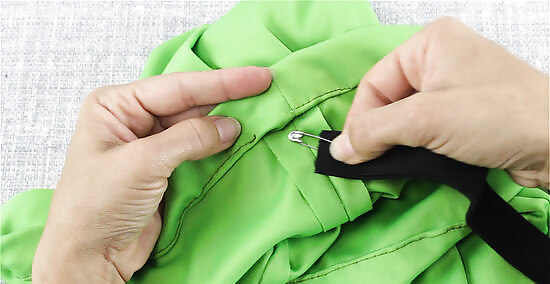
Hook a safety pin onto 1 end of the elastic if you're feeding it through casing. If you've made casing, which is like a fabric tunnel, you'll need to attach a big safety pin to 1 end of the elastic. Close the safety pin and hold the non-pinned end outside of the casing while you feed the pinned end through it. It will be easier to feel and pull the safety pin than just the end of the elastic. Once the elastic is completely through the casing, remove the safety pin and gather the ends together so they overlap by ⁄2 inch (1.3 cm). Then, sew the ends together using a zigzag stitch before you sew the casing closed with a straight stitch.
Choosing Elastic for the Waistband
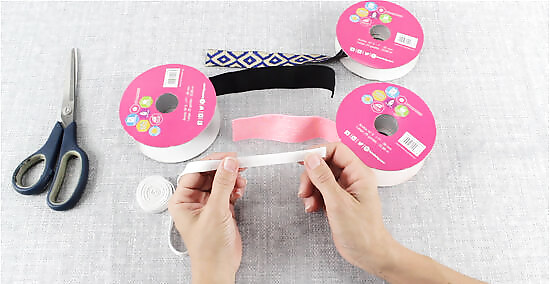
Buy knit elastic for lightweight or medium fabric. If you're making a loose skirt or lightweight shorts, for instance, pick knit elastic since it's very stretchy. This flexible elastic is really soft so it's also great if you plan on sewing the elastic waistband directly onto your fabric. You can also use knit elastic if you're sewing the waistband into a casing. Avoid using braided elastic for waistbands, since this type of elastic quickly loses its stretchiness and doesn't hold its shape well.
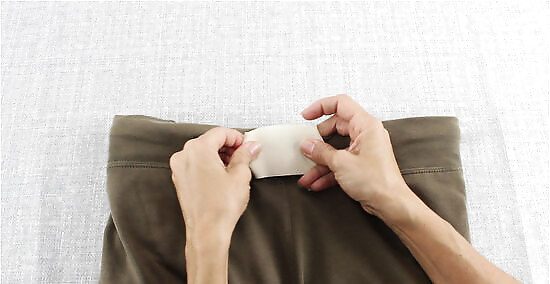
Use woven elastic for medium or heavy fabric. Woven elastic is stronger than knit elastic, but it's not as soft. This can make it a better choice for heavier fabrics, such as khaki or denim. If you like, you can sew woven elastic into a casing or directly onto fabric.
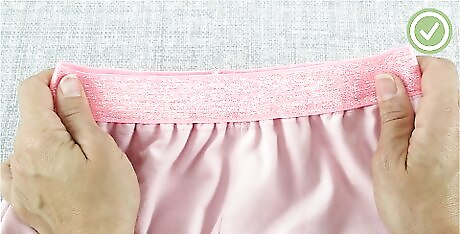
Choose white or fashion elastic based on your project. If you're inserting the elastic waistband into a casing, you'll probably want standard white elastic since it won't be visible. If you're sewing the waistband directly onto the fabric, decide if you want to buy fashion elastic that comes in bright colors or patterns. For example, if you can buy striped, polka dot, animal print, or a variety of colored elastic.
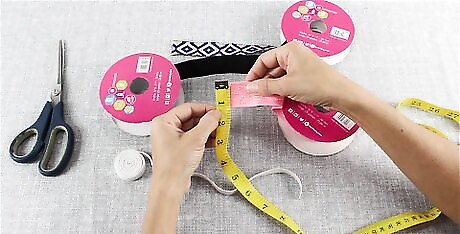
Determine how wide you want the elastic band to be. Although elastic comes in several widths, you'll probably want the elastic to be between ⁄4 to 1 inch (1.9 to 2.5 cm) wide. Keep in mind that the width will vary depending on whether you're sewing it directly onto the fabric or into casing.Tip: Think about how high you'll want the garment to sit on your waist. For most adults, narrow elastic that's around ⁄2 inch (1.3 cm) may cut into the skin or be more likely to twist if it's low on the waist. For example, if you're sewing an exposed waistband, you might want it to be over 1 inch (2.5 cm) wide. If you're making clothes for kids, get elastic that's closer to ⁄2 inch (1.3 cm) wide.



















Comments
0 comment